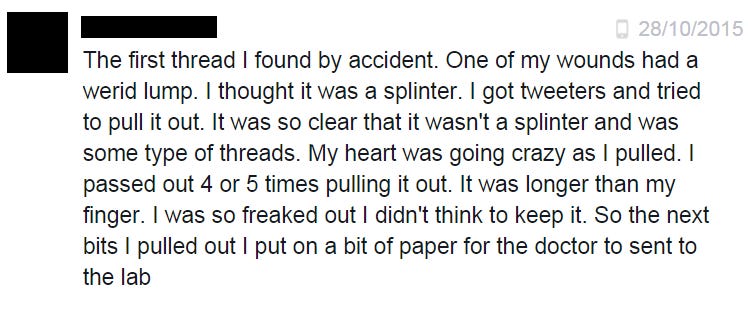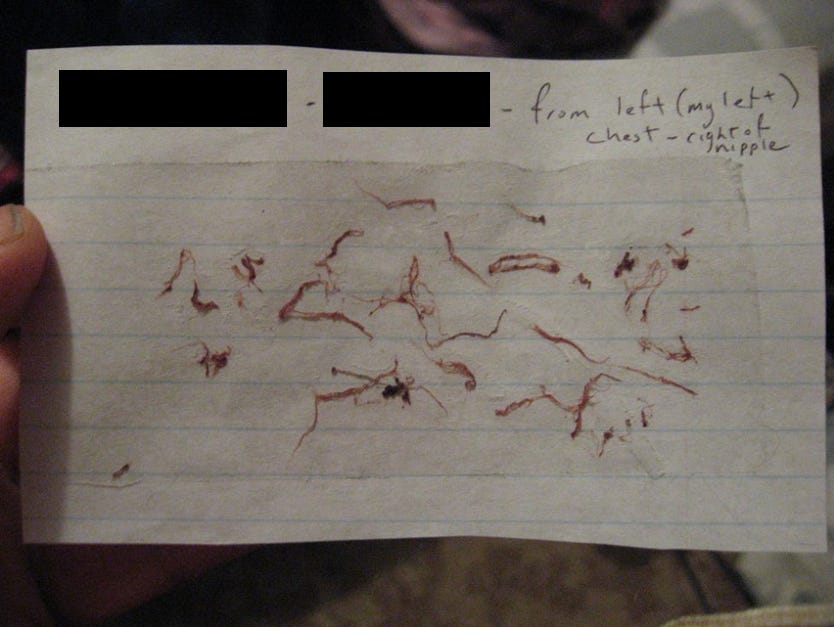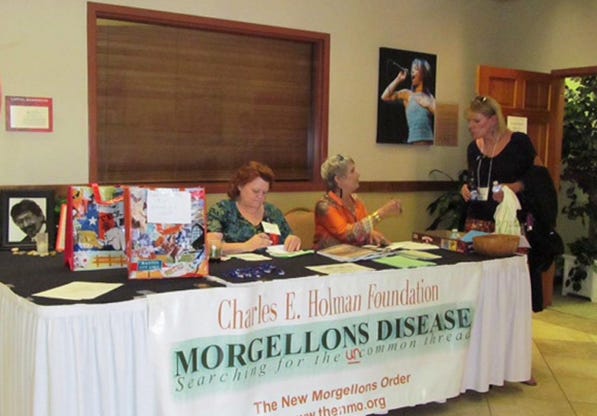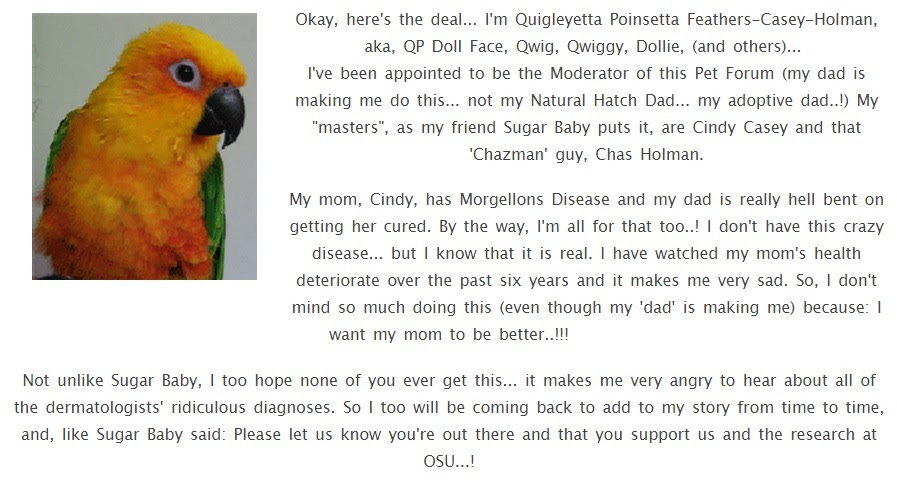Hi,
Hope the weekend went well. I had a blast reading your stories under my secret societies newsletter. Especially loved this from Steff:
“In university I won a ‘Freemason’s Scholarship’, which is hilarious because I had to go to an interview with 10 masons — and I’d just seen the movie From Hell, and all I wanted to talk about was conspiracy theories.
I won, and I got invited to attend a dinner at their Auckland lodge with my mum and my best friend. So we go off to find the bathroom, and she goes “look at this” and pulls me behind a curtain and through a door and into their secret meeting chamber.
And it looks like a movie set! I just couldn’t get over how simultaneously cool and silly it was. Like, all those lovely old men I met at dinner really hang out in here? Why don't they just go bowling?”
I loved chatting to you in the comments over the weekend, and after that I chatted to New Zealand journalist Kim Hill about what the hell is going on with New Zealand’s conspiracy scene — you can listen to our conversation here.
As for today — it’s time for a Webworm podcast. I wanted to try something every now and then where I share a piece of my writing from earlier in my career. I have stuff scattered in a variety of places — old laptops and computers, USB sticks (remember them?) and of course Google Docs.
Today’s piece was originally published on the 3News website, back when I was a journalist in New Zealand.
The website no longer exists, so neither does this piece — except, I found it in my Google Docs folder. I enjoyed revisiting it, so — like when Stephen King releases a new edition of The Stand — I decided to clean it up a little, add a few paragraphs, and re-release it into the world.
I just compared myself to one of America’s greatest writers. Not arrogant at all.
This one is a medical mystery; a rabbit hole I never expected to go down.
Trigger warning: if you’re squeamish, this might make you a bit squeamish. Nonetheless — I hope you enjoy it. Let’s travel back to 2015.
David.
Pulling on a Mysterious Thread
UFOs, chemtrails, shadowy government agents. The phone-calls usually start around 9pm. People call the newsroom with information they desperately want to tell you; information they can’t give to anyone else.
Their stories are similar and familiar — and always filled with paranoia and conspiracy. One man insists the government has put an implant in his brain, using it to track his every move. A woman calls up insisting she’s been systematically abducted by aliens for the last 15 years.
People call the newsroom — often me specifically — because they see it as their last opportunity to be understood. Or at least be heard. The police are no help. Doctors and medical professionals have turned them away. Most of them don’t even want to consider writing to the government, because the government’s in on it. They want to talk to the open-minded reporter.
None of these callers are looking for answers, because they already have the answers. Their problem is that no one will listen to them.
These far-flung stories don’t always come over the phone. Increasingly, people direct their story to my Facebook inbox or my Twitter DMs. People like Andy:
And Andy started telling his story. It was involved and complex, full of names, dates and allegations.
The messages arrived in my inbox in a steady stream. 10… 20… 86 messages by the end of the day. It was unrelenting and I didn’t know where to start. He claimed many troubling things, but there was no way to verify any of his claims.
And then he started talking about the threads.

I paused when reading this, and then I re-read it, just to clarify. I didn’t quite get it. Threads? I don’t know what he is talking about. I can’t picture it. Andy is very candid about it: “It’s not normal to be able to pull threads out of your chest. I’ve got wounds everywhere”.
Andy tells me he didn’t used to have wounds everywhere. He sent me a “before” photo, from January 2014: A topless, pasty white guy. Now the paste has turned to a blotchy mess. He sends me a more recent photo.
These splotches cover his arms, his chest, his back. He blames the splotches on the threads. It always comes back to the threads. Then he sent me a photo of what he was talking about:
There are more photos, and they all show the same thing: Andy appears to be pulling threads out of himself, just like he said he was. It’s a strange thing to look at — as I’m still not quite sure what I am seeing.
He says he’s approached various hospitals, and seen various doctors. But no answers. He sends me a report from a Diagnostic Medlab:
It report ends with “The origin of the foreign material is not apparent”.
Andy’s narrative veers back into things I can’t confirm —allegations, conspiracy and paranoia. I don’t know how founded or unfounded any of it is. “I been on the run since January 2014. I try and keep myself a moving target” he types.
He’s sleeping rough somewhere in the North Island of New Zealand. He needs to keep off the grid. He’s been contacting me when he gets Wi-Fi on his phone. “I been trying hard at great risk to my own life. I expect to die from my injuries” he sends.
It’s easy to write him off as another conspiracy theorist. But I keep on thinking about the threads. I’ve been staring at this confronting photo for a few days now, trying to figure out what exactly I’m looking at:
I feel a bit ill. I am not good with body stuff, and I am definitely not good with “bits-of-bloody-matter-pulled-out-of-the-skin” body stuff.
In saying that, I’m part of a Facebook chat group with five friends that I like to surprise, so I send the photo to them. Rachel, a speech therapist, sends an immediate reply: “Oh my gosh, he’s got Morgellons Disease”.
Devil’s Bait
Rachel had just picked up a book called The Empathy Exams, a New York Times bestseller written by Leslie Jamison. The book is about being empathetic toward people you didn’t fully understand. One of the chapter’s was called “Devil’s Bait”:
“For me, Morgellons disease started as a novelty: people said they had a strange disease, and no one — or hardly anyone — believed them.
There there were a lot of them, almost 12 thousand of them — and their numbers were growing.
Their illness manifested in lots of ways: Sores, itching, fatigue, pain, and something called formication, the sensation of crawling insects.
But its defining symptom was always the same: Strange fibres emerging from underneath the skin”.
This sounded exactly like Andy.
I immediately went on a Googling rampage, finding examples of Morgellons all over the world, from the United States to Japan.
The diagnosis started with Mary Leitao, who in 2001 took her two-year-old to the doctor to examine a crusty sore on his lip. The kid was complaining about some bugs crawling around under his skin. Doctors found nothing wrong, prescribing some vaseline.
But the sore didn’t go away, the fibres arrived, and Leitao came up with the term “Morgellons” — referencing something written by a 17th Century doctor about some “harsh hair” he’d found emerging on a patient’s back.
Ms. Leitao collects a sample of the strands from Drew’s skin. They glide right off, like filaments from a dandelion.
She places them onto slides, examining them under an $8 RadioShack microscope. She’s looked thousands of times into microscopes, fancier ones, first as a biology student at the University of Massachusetts-Boston, and later for five years as a medical researcher at two Boston hospitals.
She’s seen nothing like this before. She shakes her head and thinks, “These things cannot be coming out of my son’s body.”
Once the condition had a name, people started coming out of the woodwork. Patients would collect the threads they’d pulled out of themselves and bring it to their GP in little containers or matchboxes.
Dermatologists even coined a term for it: “The matchbox sign”. The consensus was that the fibres or “alien bodies” weren’t from within the body, but were just bits of cotton and wool people found on their skin.
I thought of my guy, Andy, and his collection of bloody, fleshy fibres laid out on a paper towel. Then I thought of that photo of him pulling them out of his body. They weren’t bits of wool from his fucking sweater. What was going on?
A Disease You Catch Online
The Centre for Disease Control launched a full scale investigation in 2006 to get to the bottom of Morgellons. They didn’t get to the bottom of it.
The report was called Clinical, Epidemiologic, Histopathologic and Molecular Features of an Unexplained Illness and concluded:
“We were not able to conclude based on this study whether this unexplained dermopathy represents a new condition, or a wider recognition of an existing condition such as delusional infestation”.
That delusional infestation thing is important.
Body horror — think David Cronenberg’s The Fly and Eraserhead — isn’t just a movie genre, but has long been a phenomenon dealt with by psychologists the world over.
An idea seeds itself in a patient’s mind: something is crawling under their skin and they have to get it out. Sometimes it’s called delusional parasitosis or Ekbom’s syndrome. Delusory cleptoparsitosis is another one, closely related to a paranoia of bed bugs.
In one extreme case several years ago a woman scratched through her scalp and her skull using household implements until she was scratching at her own brain:
Only in the Emergency Department at Massachusetts General Hospital, after the doctors started swarming, and one told her she needed surgery now, did M. learn what had happened. She had scratched through her skull during the night — and all the way into her brain.
I’m not quite sure how you scratch through your skull — maybe some artistic licence there. But you get the idea: It’s an itch you can’t scratch, and it drives you crazy.
I mention these other conditions because they lead to another theory about Morgellons: that it’s passed on through the Internet. The Empathy Exams labels the process “Transmission by Internet.”
Morgellons disease wasn’t termed until 2001: it’s grown up on the web — through message boards, group chats, Facebook and Twitter. It’s an idea. An idea that becomes so powerful it’s utterly invasive. The meme to end all memes. A meme exploding out of your own body.
Doctors generally agree the wounds you see on Morgellons patients are self-inflicted. A patient believes there is something under the skin, and they attempt to dig it out. It’s based around a whole lot of paranoia, and it can spread.
Patients are often described as delusional. Google “Morgellons”, and pretty soon you’ll find fringe literature fraught with government conspiracies, the New World Order, and chemtrails.
I think back to Andy and the stories he can’t verify and the fact he’s been on the run for a year. Sounds pretty Level 5 to me.
But here’s the thing: not all scientists believe Morgellons is a delusion.
Belief v Science
About 15 years ago, molecular scientist Randy Wymore from Oklahoma State University got patients to send their fibres to him — and he noticed the threads all looked pretty similar: most were either blue or red.
He sent them to a forensics lab for analysis. They didn’t match any of the 900 textiles on the Tulsa Police Department’s forensic lab’s database. Next the threads were heated to 371 degrees Celsius. Nothing happened: no fire, no disintegration, no nothing. This meant they weren’t one of the at least 85,000 different organic compounds that would catch fire.
With all this in mind, you go to Oklahoma State University’s website today and you find this paragraph:
Morgellons is a multi-symptom disease that is currently being researched at the OSU Center for Health Sciences. Morgellons Disease is frequently misdiagnosed as delusional parasitosis or obsessive picking disorder.
They’re not treating it like woo. They’re treating it like science. And for thousands of sufferers all over the world, this comes as a huge relief. Because they’re accustomed to being laughed out of the door.
The Charles E Holman Foundation started an annual conference in Austin, Texas for Morgellons patients and researchers to gather and share their knowledge. It’s mostly attended by women because 70% of Morgellons sufferers are female, and white. No-one knows why.
The organisation was started by Charles Holman, whose wife suffered from the disease. He died. She lived on and still runs the conference. She’s still pulling fibres out of her skin.
Photos from their events show them taking place in churches and school halls with makeshift tables and signs. It has the air of a pedigree cat show — people united by their passion for something extraordinary. Their motto last year was “Searching for the common thread”. Someone’s scribbled on the sign so it says “uncommon”.
They’re not devoid of a sense of humor.
The author of The Empathy Exams, Leslie Jamison, ended up attending a conference. She experienced some of the paranoia around Morgellons first hand:
“Doubting Morgellons hasn’t stopped me being afraid I’ll get it [...] Now that I am here, I wash my hands a lot. I am conscious of other people’s bodies. Then it starts happening: And I knew it would. After a shower, I notice small blue strands curled up like tiny worms across my clavicle.
I’ve got these fleeting moments of catching sight, catching panic. It’s in these moments of fear that I come closest to experiencing Morgellons in the way its patients do: its symptoms physical and sinister, its tactics utterly invasive.”
I email the organiser to see what the plan is for next year. “They are definitely planning a conference for next year, but we don’t have any dates yet,” she tells me.
I make a note that I’ll check back in. I want to go. In the meantime I order a calendar from last year’s event. Each month has a different image of Morgellons.
I browse the foundation’s website and find a forum called “The Pets of Morgellons”. I spot a kitten, a dog and a bright orange parrot.
It’s a lot to grasp where the science ends and the delusion begins.
Freaking Out
Morgellons has its celebrity backers. 71-year-old Canadian singer Joni Mitchell is plagued by threads bursting from her pores, as the Daily Mail pointed out:
“Joni Mitchell’s mystery ailment revealed: Morgellon’s Disease sufferers claim they feel parasites crawling and biting under their skin before colorful fibers grow from the sores – but experts say it is a mental illness”
That last bit of the headline is what really ruffles the feathers of Morgellons sufferers: “Mental illness.” It’s a refrain that keep coming up again and again. “The matchbox sign” from earlier.
There are 12,000 people who claim to be suffering from Morgellons. Are they all a victim to the same mass delusion? That’s what most doctors say. Randy Wymore from Oklahoma State University would disagree.
As I look back at Andy’s photos, I wonder. Most sufferers seem to think they’re pulling out biological material that’s been growing inside them. That’s what makes Morgellons different to delusional parasitosis or delusory cleptoparsitosis. In those cases, people think outside bodies have gotten in: bugs, parasites and creepy crawlies.
The horror that Morgellons patients find themselves in is their own body turning against them. It’s like finding an extra tooth that didn’t used to be there, or some other kind of biological surprise.
The last thing Andy types to me is: “You can guess it freaks me out, as it is my body”.
Things bursting from his skin, and no-one can explain why. Fear seems like an incredibly sane reaction to me.
David Farrier, 2015.
Hi, me again — here in 2021.
I edited the story a little, as I wrote a little differently back in 2015 — and wanted to change some phrasing.
It did have me wanting to know how Andy’s doing these days. I’ve been back through my Facebook messages, and he’s deleted his account. I never got his email or phone number — he was too paranoid.
I hope he’s doing okay. I hope he’s found some peace.
I was actually reminded of this piece because of something that happened recently — back in June. The paranoia seen with Morgellons is sometimes compared to the phenomenon of “Targeted Individuals” and “Gang Stalking” — in which victims think they are being followed and monitored in some way.
While Morgellons has Joni Mitchell, “Gang Stalking” has Modest Mouse’s Isaac Brock:
“I started doing all this videotaping, and found multiple people were following me. The same car, the same place.
It’s been a year and a half since I’ve actually had solid gang stalking […]
At the point when I was writing, the physical gang-stalking had stopped, but it did feel like I was what is called a targeted individual. It’s basically just a bunch of tinfoil hat shit, but time will tell.”
That interview was from June this year, and it got me thinking of poor Andy. Tinfoil hat shit. Time will tell.
I’m curious what you make of all this. Have you had anyone in your life that’s descended down this particular psychological rabbit hole? I can’t help but draw comparisons to the illogical, conspiracy-fuelled world so many seem to occupy in 2021. What’s going on with our brains? What’s going on with the way we perceive reality?
David.
PS: Share this particular newsletter, if you like: it’s www.webworm.co/p/ontherun or —
I appreciate you getting the word out about Webworm!
























“I've been on the run since 2014. I try & keep myself a moving target”